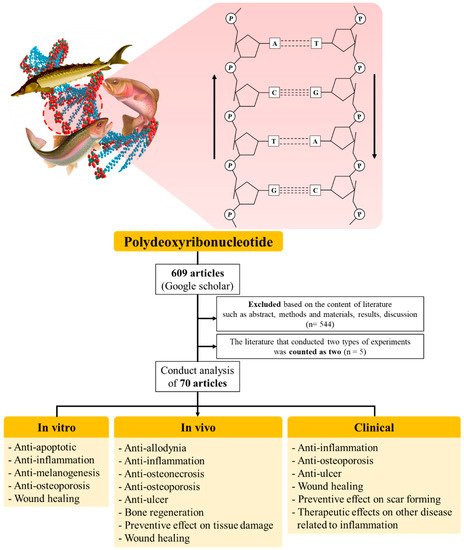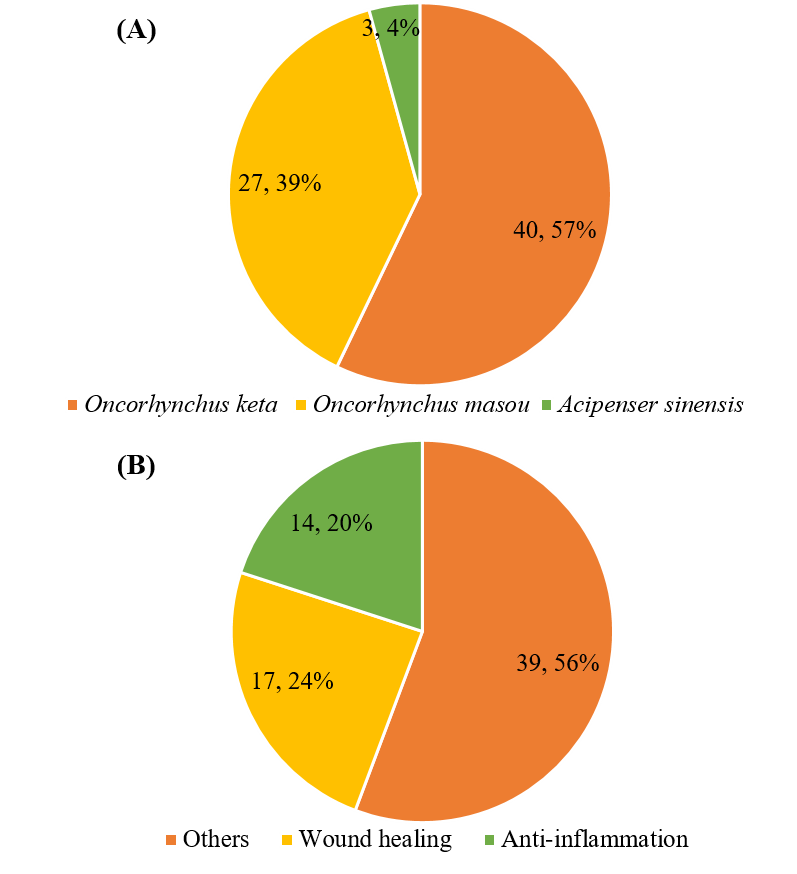
| Version | Summary | Created by | Modification | Content Size | Created at | Operation |
|---|---|---|---|---|---|---|
| 1 | Won-Kyo Jung | + 822 word(s) | 822 | 2021-05-26 04:27:16 | | | |
| 2 | Nora Tang | Meta information modification | 822 | 2021-05-26 10:42:33 | | |
Video Upload Options
Polydeoxyribonucleotides (PDRNs) are a family of DNA-derived drugs with a molecular weight ranging from 50 to 1500 kDa, which are mainly extracted from the sperm cells of salmon trout or chum salmon. Many pre-clinical and clinical studies have demonstrated the wound healing and anti-inflammatory properties of PDRN, which are mediated by the activation of adenosine A2A receptor and salvage pathways, in addition to promoting osteoblast activity, collagen synthesis, and angiogenesis. In fact, PDRN is already marketed due to its therapeutic properties against various wound healing- and inflammation-related diseases.
1. Introduction
Polydeoxyribonucleotide (PDRN), an active mixture of polynucleotides with a molecular weight ranging from 50 to 1500 kDa, is mainly extracted and purified from the sperm cells of Salmon trout (Oncorhynchus mykiss) or Chum Salmon (Oncorhynchus keta). Importantly, PDRN exhibits a high DNA percentage without active proteins or peptides [1][2]. This compound is currently used as a type of DNA-derived commercial drug, which has been approved by the Korea Food and Drug Administration and is often implemented in tissue repair and wound treatment [3]. PDRN is also reportedly an agonist against the adenosine A2A receptor (A2AR), which regulates myocardial blood flow, suppresses immune cell activation, and regulates the release of glutamate and dopamine [4][5]. Additionally, PDRN stimulates nucleic acid synthesis by serving as a source of pyrimidines and purines [5]. Further, PDRN possesses several therapeutic properties, including angiogenesis-promoting, anti-apoptotic, anti-inflammatory, anti-ischemic, and tissue repair activities [6][7][8][9].
This review summarizes the current state of PDRN research, including the therapeutic effects and applications of this compound. To facilitate their discussion, these breakthroughs will be classified as in vitro, in vivo, and clinical studies. Finally, we will discuss the challenges and recent trends in PDRN research (Figure 1).

Figure 1. A wide range of therapeutic applications in the field of PDRN.
2. Development and Findings
This review analyzed and discussed the therapeutic effects and applications of PDRNs extracted from marine organisms. A total of 70 studies published from 2016 to 2020 were analyzed and summarized. Analysis of the published years indicated that the highest number of PDRN-related articles during the study period was published in 2018, whereas 2019 had the lowest publication output. Nevertheless, publication numbers increased once again in 2020, suggesting that the number of studies on the therapeutic effects and applications of PDRNs will likely increase after 2020. As illustrated in Figure 2A,D, PDRNs primarily possess anti-inflammatory and wound healing properties, and are the mainly extracted from O. keta and O. mykiss.

Figure 2. The number of articles about PDRN from 2016 to 2020 (n = 70). (A) Extraction sources, (B) Companies provided, (C) kind of study, and (D) pharmaceutical activities of PDRN.
Although PDRN exhibits many pharmacological properties, several limitations and weaknesses remain in terms of extraction source, used concentration, application, and underlying mechanism.
Firstly, O. keta and O. mykiss sperm are rather difficult to obtain, as these organisms only spawn during the breeding season, making Ok- and Om-PDRN prohibitively costly. Second, all studies in this review used commercially produced PDRN, not extract PDRN. Therefore, the concentration used in these experiments was fixed at under 1.875 mg/mL because commercial products are provided at a concentration of 5.625 mg/3 mL. Therefore, PDRN has the potential to show a stronger therapeutic effect at a higher concentration than 1.875 mg/mL. Regarding the modes of PDRN administration, most studies have injected these compounds directly at the wound site. Finally, the underlying mechanisms of PDRN were demonstrated by only five articles as MAPK activation [10][11][12][13][14]. Despite the limitations of PDRN, it has recently garnered much attention as a promising drug for several diseases.
Several sources other than O. keta and O. mykiss were used for PDRN extraction, including humans and plants. From 2016 to 2020, one article investigated the potential of PDRN extracted from humans on chronic ulcer treatment [15]. However, human PDRN has an ethical problem in obtaining an extraction source, similar to Ok- and Om-PDRN. Nowadays, several companies are trying to extract PDRN from plants such as roses, aloe, and broccoli [16][17][18]. When PDRN is extracted from plants, an additional process is required to break down the cell wall of plants, unlike animal-sourced PDRN. Due to the limitations of the alternatives (ethic problems and the need for additional processes), marine organisms are the best and most cost-effective materials from which to extract PDRN.
Biomedical engineering (BME) is a rapidly developing field of medical and biological research that provides new concepts and strategies for the diagnosis, treatment, and prevention of various diseases [19][20][21]. The main goal of BME is the development and application of new therapies and technologies to support, repair, or replace damaged cells, tissues, and organs with alternative systems of a bio-artificial nature [22]. Biomaterials are among the key elements of BME research and there are many ongoing efforts to develop more effective and safe biomaterials [23][24][25][26].
Therefore, additional research is needed not only to further characterize the therapeutic effects of PDRN but also to identify more cost-effective extraction sources such as starfish, algae, and unstudied marine organisms. Additionally, BME-based PDRN administration strategies, including hydrogels, three-dimensional scaffolds, nanofibers, and films, must be further developed to enhance the pharmacological activity of PDRN.
References
- Pallio, G.; Bitto, A.; Pizzino, G.; Galfo, F.; Irrera, N.; Squadrito, F.; Squadrito, G.; Pallio, S.; Anastasi, G.P.; Cutroneo, G.; et al. Adenosine receptor stimulation by polydeoxyribonucleotide improves tissue repair and symptomology in experimental colitis. Front. Pharmacol. 2016, 7, 273.
- Pallio, G.; Bitto, A.; Ieni, A.; Irrera, N.; Mannino, F.; Pallio, S.; Altavilla, D.; Squadrito, F.; Scarpignato, C.; Minutoli, L. Combined treatment with polynucleotides and hyaluronic acid improves tissue repair in experimental colitis. Biomedicines 2020, 8, 438.
- Squadrito, F.; Bitto, A.; Irrera, N.; Pizzino, G.; Pallio, G.; Minutoli, L.; Altavilla, D. Pharmacological activity and clinical use of PDRN. Front. Pharmacol. 2017, 8, 224.
- Ko, I.-G.; Jin, J.-J.; Hwang, L.; Kim, S.-H.; Kim, C.-J.; Han, J.H.; Lee, S.; Kim, H.I.; Shin, H.P.; Jeon, J.W. Polydeoxyribonucleotide exerts protective effect against CCl4-Induced acute liver injury through inactivation of NF-κB/MAPK signaling pathway in mice. Int. J. Mol. Sci. 2020, 21, 7894.
- Kwon, D.R.; Park, G.-Y.; Lee, S.C. Treatment of full-thickness rotator cuff tendon tear using umbilical cord blood-derived mesenchymal stem cells and polydeoxyribonucleotides in a rabbit model. Stem Cells Int. 2018, 2018, 7146384.
- An, J.; Park, S.H.; Ko, I.-G.; Jin, J.-J.; Hwang, L.; Ji, E.-S.; Kim, S.-H.; Kim, C.-J.; Park, S.Y.; Hwang, J.-J.; et al. Polydeoxyribonucleotide ameliorates lipopolysaccharide-induced lung injury by inhibiting apoptotic cell death in rats. Int. J. Mol. Sci. 2017, 18, 1847.
- Lee, D.-W.; Hyun, H.; Lee, S.; Kim, S.Y.; Kim, G.-T.; Um, S.; Hong, S.O.; Chun, H.J.; Yang, D.H. The effect of polydeoxyribonucleotide extracted from salmon sperm on the restoration of bisphosphonate-related osteonecrosis of the jaw. Mar. Drugs 2019, 17, 51.
- Shin, D.Y.; Park, J.-U.; Choi, M.-H.; Kim, S.; Kim, H.-E.; Jeong, S.-H. Polydeoxyribonucleotide-delivering therapeutic hydrogel for diabetic wound healing. Sci. Rep. 2020, 10, 16811.
- Jeong, W.; Yang, C.E.; Roh, T.S.; Kim, J.H.; Lee, J.H.; Lee, W.J. Scar prevention and enhanced wound healing induced by polydeoxyribonucleotide in a rat incisional wound-healing model. Int. J. Mol. Sci. 2017, 18, 1698.
- Noh, T.K.; Chung, B.Y.; Kim, S.Y.; Lee, M.H.; Kim, M.J.; Youn, C.S.; Lee, M.W.; Chang, S.E. Novel anti-melanogenesis properties of polydeoxyribonucleotide, a popular wound healing booster. Int. J. Mol. Sci. 2016, 17, 1448.
- Shrestha, S.; Shrestha, S.M.; Pradhan, A.; Aryal, S. Platelet rich fibrin and bone graft in the treatment of intrabony defect in periodontitis patients. J. Nepal. Soc. Periodontol. Oral Implantol. 2018, 2, 49–55.
- Hwang, K.-H.; Kim, J.-H.; Park, E.Y.; Cha, S.-K. An effective range of polydeoxyribonucleotides is critical for wound healing quality. Mol. Med. Rep. 2018, 18, 5166–5172.
- Kim, S.-E.; Ko, I.-G.; Jin, J.-J.; Hwang, L.; Kim, C.-J.; Kim, S.-H.; Han, J.-H.; Jeon, J.W. Polydeoxyribonucleotide exerts therapeutic effect by increasing VEGF and inhibiting inflammatory cytokines in ischemic colitis rats. BioMed Res. Int. 2020, 2020, 2169083.
- Lee, S.; Won, K.Y.; Joo, S. Protective effect of polydeoxyribonucleotide against CCl4-induced acute liver injury in mice. Int. Neurourol. J. 2020, 24 (Suppl. 2), 88–95.
- Zhang, X.-Y. Biomedical engineering for health research and development. Eur. Rev. Med. Pharmacol. Sci. 2015, 19, 220–224.
- Zhong, Q.; Ding, H.; Gao, B.; He, Z.; Gu, Z. Advances of microfluidics in biomedical engineering. Adv. Mater. Technol. 2019, 4, 1800663.
- Hashimoto, S. Multidisciplinary learning extends communication skill, and helps cross cultural understandings: Biomedical engineering. J. Syst. Cybern. Inf. 2017, 15, 106–112.
- Repanas, A.; Andriopoulou, S.; Glasmacher, B. The significance of electrospinning as a method to create fibrous scaffolds for biomedical engineering and drug delivery applications. J. Drug Deliv. Sci. Technol. 2016, 31, 137–146.
- Kim, T.-H.; Jung, W.-K. R&D Trends of brown algae as potential candidates in biomedical application. J. Mar. Biosci. Biotechnol. 2019, 11, 1–13.
- Heo, S.-Y.; Ko, S.C.; Nam, S.Y.; Oh, J.; Kim, Y.-M.; Kim, J.-I.; Kim, N.; Yi, M.; Jung, W.-K. Fish bone peptide promotes osteogenic differentiation of MC3T3-E1 pre-osteoblasts through upregulation of MAPKs and Smad pathways activated BMP-2 receptor. Cell Biochem. Funct. 2018, 36, 137–146.
- Kim, T.H.; Lee, H.S.; Oh, S.-J.; Hwang, C.-W.; Jung, W.-K. Phlorotannins ameliorate extracellular matrix production in human vocal fold fibroblasts and prevent vocal fold fibrosis via aerosol inhalation in a laser-induced fibrosis model. J. Tissue Eng. Regen. Med. 2020, 14, 1918–1928.
- Lee, H.S.; Jeong, M.-S.; Ko, S.-C.; Heo, S.-Y.; Kang, H.W.; Kim, S.W.; Hwang, C.W.; Lee, K.D.; Oak, C.; Jung, M.J.; et al. Fabrication and biological activity of polycaprolactone/phlorotannin endotracheal tube to prevent tracheal stenosis: An in vitro and in vivo study. J. Biomed. Mater. Res. Part B 2020, 108, 1046–1056.
- Chen, X.; Zhou, W.; Zha, K.; Liu, G.; Yang, S.; Ye, S.; Liu, Y.; Xiong, Y.; Wu, Y.; Cao, F. Treatment of chronic ulcer in diabetic rats with self assembling nanofiber gel encapsulated-polydeoxyribonucleotide. Am. J. Transl. Res. 2016, 8, 3067–3076.
- Han, K.; Ha, J.; Hur, W. Preparation Process for Polynucleotide Fragments from Plant and Non-Aqueous Composition Containing the Same. KR Patent 10-2016-0012504, 1 February 2016.
- Kim, J.S.; Shin, D.K. Cosmetic Composition for Anti-Aging Activity Comprising DNA Originated Strawberry. KR Patent 10-2015882, 8 April 2019.
- Ki, K.H.; Lee, J.E.; Kim, Y.E.; Joo, I.W. Method of Producing DNA Derived from Aloe Genus Plant, and Composition Containing DNA Derived from Aloe Genus Plant for Anti-Aging and Anti-Inflammation. KR Patent 10-2019-0021328, 22 February 2019.




